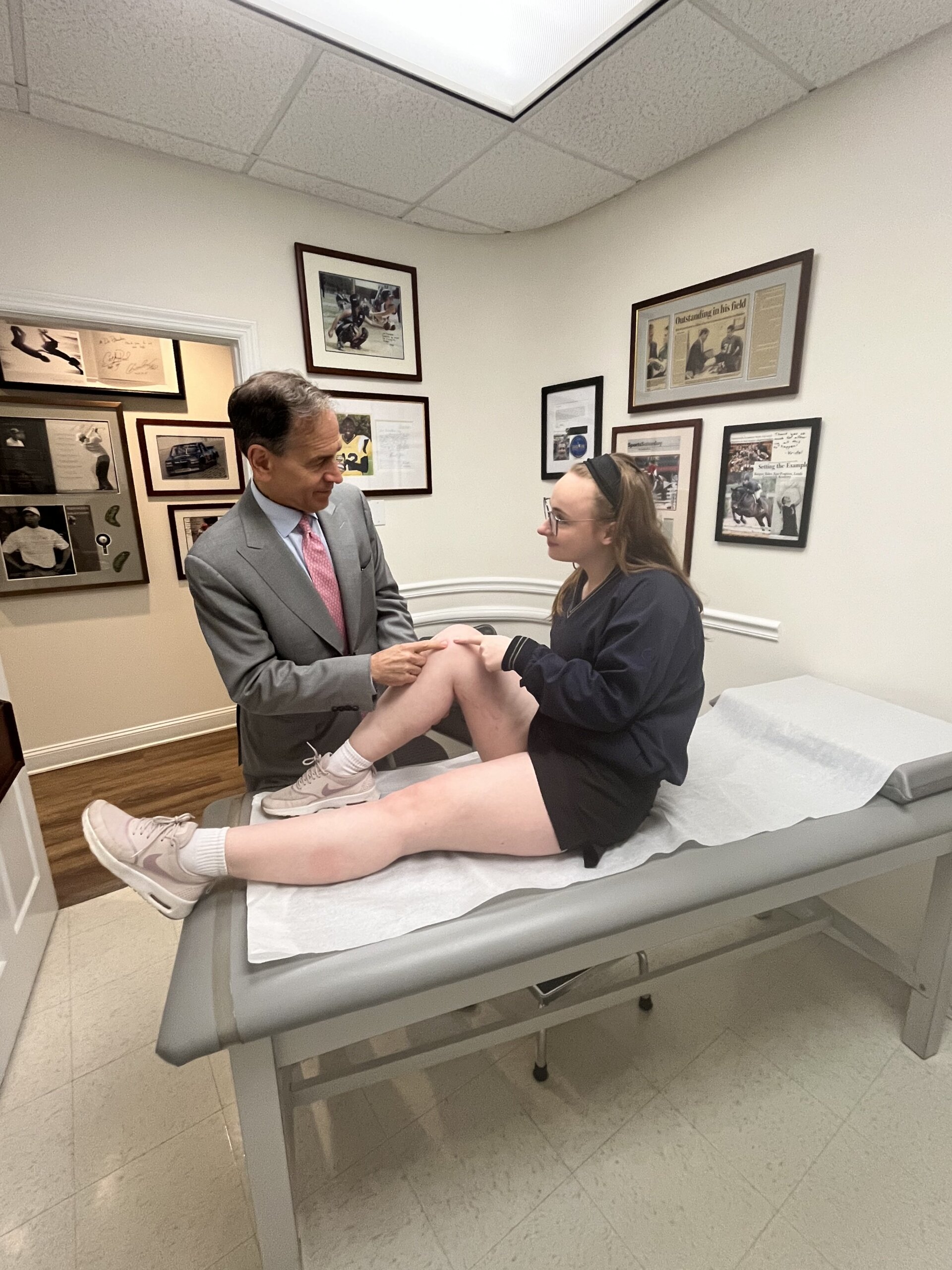Resuming sports after knee arthroplasty requires care and knowledge to ensure safety and success. We’ll explore returning to sports after knee arthroplasty safe practices that allow you to confidently step back into your athletic life without compromising your health. From understanding recovery timelines to embracing the right exercises and sport-specific techniques, this guide from Plancher Orhtopaedics is tailored for athletes dedicated to protecting their new knee on and off the field.
Key Takeaways
- Recovery from knee arthroplasty is a marathon requiring adherence to a phased rehabilitation plan, starting with healing and pain management, then progressing to strength and flexibility, and finally maintaining long-term endurance and joint health.
- Incorporating appropriate warm-up and cool-down routines, as well as knee strengthening and flexibility exercises, is essential for a safe return to sports, helping to prepare the body for physical activity and to prevent injury or stress to the new knee.
- A collaborative care approach with healthcare providers, alongside technique adjustment, sporting gear optimization, and healthy lifestyle choices (including nutrition and weight management), is crucial in ensuring sustainable knee joint health and successful re-engagement in sports post-knee arthroplasty.
Navigating Recovery Timelines
Returning to sports following knee arthroplasty is a process akin to a marathon rather than a sprint. This journey, meticulously charted from rest and healing to stages of progressive activity, varies for each individual. Each person’s path is unique, and while the desire to jump back into sports is strong, acknowledging the importance of a tailored and consistent rehabilitation plan will set you on the course for a successful return.
Grasping the recovery timelines for knee replacement patients, from the immediate post-partial knee replacement surgery steps to the long-term care of your new knee, marks the first significant stride in reclaiming your active lifestyle.
Initial Phase: Healing and Pain Management
In the wake of knee arthroplasty, the starting line is all about healing and pain management. Under the guidance of a physical therapist, you’ll navigate the significant pain that follows surgery with strategies like ice packs, medication, and elevating the leg. Gradually, as the pain subsides, you’ll shift from assistive devices to walking unassisted, all the while adhering to a physical therapy regimen that lays the foundation for recovery.
This phase sets the stage for the remainder of your recovery journey, optimizing clinical outcomes for a successful return to an active life for active patients.
Intermediate Phase: Building Strength and Flexibility
Transitioning into the intermediate phase, it’s time to build muscle and bend those joints into submission. Here, physical therapy takes a more assertive role, with daily exercises aiming to restore strength and improve the knee’s range of motion. It’s a period where the groundwork laid in the initial phase begins to pay off, allowing for more dynamic movements and the gradual introduction of intermediate-impact sports.
Perseverance is the hallmark of this stage as you gradually rehabilitate your knee to its previous strength and functionality.
Advanced Phase: Enhancing Endurance
As the journey continues, the advanced phase beckons with a promise of renewed vigor and endurance. Exercises become more challenging, incorporating mini squats, leg balances, and step-ups to fortify the muscles surrounding your knee. It’s during this phase that you’ll begin to feel the pull of an active life within reach once more, as you add light ankle weights and resistance to your exercises.
Approach the upcoming exercises with zeal, as every step taken propels you closer to resuming your athletic pursuits.
Long-Term Maintenance
The long-term maintenance phase is the ongoing commitment to the health and longevity of your knee implant. Regular exercise not only keeps the muscles strong but also ensures the knee joint remains flexible and well-lubricated. It’s about setting a routine that includes check-ups with your surgeon, especially if you were younger at the time of surgery and lead an active lifestyle.
Consider this stage not as an endpoint but a fresh start, aimed at preserving your progress and leading a more vibrant, active life.
Pre-Sport Warm-Up and Cool-Down Strategies
Prior to re-entering the arena of athletic activity, understanding the ritual of warm-up and cool-down is paramount. They are the protective spells that guard against knee pain and aid in the recovery process, ensuring that your transition back into the sports med world is smooth and free from setbacks.
The exercises suggested below will equip your body for the rigors of sports such as tennis or contact sports while fostering a smoother recovery post-play.
Dynamic Warm-ups
Embrace dynamic warm-ups as your prelude to an active lifestyle. These are not your average stretches; they’re a series of movement-based activities tailored to the physical demands of your chosen sport. Engaging the quadriceps, hamstrings, and gluteus muscles, these exercises prime your knee for the vigorous activity to come. Consider these exercises as a rehearsal for your athletic performance, akin to tuning an orchestra before the symphony of sports commences.
Effective Cool-Downs
After the thrill of the game, it’s time to wind down. Effective cool-downs are the gentle decrescendo following the crescendo of your athletic activity. They involve progressively slower movements that help reduce muscle soreness and aid in the overall recovery process.
Devote time for cooling down after sports; your body will appreciate it, facilitating a more comfortable recovery and preparing you for the next sporting endeavor.
Strengthening and Flexibility Workouts Post-Knee Arthroplasty
Beyond the initial recovery, strengthening and flexibility workouts become the pillars of your post-knee arthroplasty fitness regime. As you incorporate resistance band exercises and engage in tailored movements like straight leg raises, you’ll notice a newfound muscle fortitude enveloping your knee. Flexibility, too, takes center stage, as yoga and stretching exercises extend the capabilities of your joint, enhancing your return to sports after knee replacement.
Bear in mind, that deriving joy from these activities is key to sustaining motivation, transforming them from mere routine into a rewarding part of your life.
Knee-Strengthening Exercises
The globe of knee health revolves around strengthening exercises after a knee replacement. Some activities that can help strengthen the muscles that support your new knee include:
- Quadriceps sets
- Cycling
- Walking
- Stair climbing
- Core muscle strengthening
These exercises will ensure that your knee is ready to withstand the pressures of your beloved sports.
As you make progress, incorporating resistance will stand as a testament to your recovery, signaling the restoration of your knee’s former strength.
Flexibility Routines
Flexibility is the unsung hero of joint health, especially post-knee arthroplasty. Through stretches like sitting unsupported knee bends and assisted knee bends, you’ll reclaim the range of motion that is so crucial to your athletic endeavors. These routines gently yet persistently guide your knee toward a realm of fluidity and grace.
Balance and Stability Training
As you set your sights on returning to the field or court, balance and stability training become your secret weapons. These exercises are the crux of a successful comeback, ensuring that your knee is not just strong but also capable of responding to the quick pivots and sudden stops that define athletic activity.
Incorporate one-legged stands, sit-to-stands, and heel-to-toe walks into your routine, and observe your performance soar to new heights.
Core Stability
The core is the foundation upon which all movement is built, especially when it comes to supporting knee stability and function. Strengthening the core through exercises like pelvic tilts and bridges not only benefits your knee but also enhances your overall athleticism.
Planks, dead bugs, and bird dogs will become part of your arsenal, targeting deep core muscles in a low-impact yet highly effective manner.
Proprioceptive Training
Proprioceptive training is the art of fine-tuning your body’s awareness, an essential component for athletes returning to sports post-knee arthroplasty. Engage in exercises like balance boards and single-leg stands to retrain your knee’s sensorimotor system, enhancing your balance and coordination.
Progressively, include dynamic movements such as squats and lunges to condition your knee to withstand the unpredictable demands of sports.
Smart Sportswear Choices Post-Surgery
Your return to sports is not just about the exercises you do but also the gear you choose. Smart sportswear choices, such as choosing supportive footwear and considering knee braces, play a pivotal role in managing the demands placed on your knee implant during athletic activities.
Whether you’re jogging on pavement or swinging on a golf course, the right equipment selection is critical for safeguarding your knee and extending the life of your implant.
Footwear Selection
When it comes to footwear selection, think of your shoes as the guardians of your gait. Lightweight, supportive, and cushioned shoes are your best allies in promoting a normal walking pattern and minimizing stress on your knee.
Athletic shoes, with their enhanced support, are a top choice for those navigating the road to recovery.
Protective Equipment
Protective equipment, such as knee braces with side stabilizers and patella support, is not just an accessory; it’s a necessity. These braces offer targeted stabilization, safeguarding your knee during the twists and turns of sports activities.
Hinged knee braces, in particular, are engineered to back up your hip and knee after hip and knee replacements, providing valuable support for a confident return to the games you love following hip and knee arthroplasty. Consult with hip and knee surgeons to determine the best brace for your needs.
Technique Adjustment and Sports Modification
Adapting your sports technique and selecting the right sports can be a game-changer post-knee arthroplasty. It’s about embracing low-impact activities that respect the mechanical limitations of your implant and seeking modifications that allow you to continue engaging in the sports you’re passionate about.
Appropriate adjustments can enable you to continue indulging in a variety of athletic activities, including high-impact sports and:
- Swimming
- Golf
- Cycling
- Yoga
- Pilates
- Walking
- Low-impact aerobics
These activities can be enjoyed without compromising the health or longevity of your knee replacement.
Low-Impact Modifications
Low-impact sports are your allies in the quest to return to an active lifestyle post-surgery. With sports like walking, cycling, and golf, you can engage in physical activities that are gentle on your knee, allowing for a smoother and safer transition back into the sports world.
Embrace these activities at the right time, around 12 to 13 weeks post-surgery, and enjoy the journey back to your athletic pursuits.
Technique Tweaks
Even high-level tennis and judo are within reach post-knee joint replacement with the right technique tweaks. Partnering with a specialist trainer can help you adjust your playing methods to accommodate your new knee, mitigating the risk of injury while allowing you to indulge in the sports you love.
Remember, the goal isn’t merely to return to the game but to play intelligently, protecting your knee for numerous future matches.
Collaborative Care Plan with Healthcare Providers
A collaborative care plan crafted with your healthcare providers, including an orthopaedic surgeon, is your roadmap to safely returning to sports activities after knee arthroplasty. Engaging with physiotherapists and surgeons, you can develop a plan that not only includes the right exercises and sports modifications but also integrates technique adjustments tailored to your recovery.
Consider this plan as your compass, steering you through the landscape of recovery, ensuring every step is purposeful and informed by the consideration of long-term knee health.
Personalized Activity Plans
Your active life post-surgery will flourish with a personalized activity plan. It considers your prior experience, activity levels, and the specifics of your knee arthroplasty, ensuring the sports you return to are both enjoyable and suitable for your new knee. Whether you’re a golfer or a tennis player, your plan will reflect your individual needs, supported by the advice of your surgeon and physical therapist.
Monitoring Progress
Just as a well-oiled machine requires regular maintenance, your knee’s health demands ongoing care and consistent follow-up appointments. These check-ups are the checkpoints in your recovery journey, allowing you to adjust your activity plan as needed and ensuring that your knee continues to serve you well in your athletic endeavors.
Regular assessment of your knee’s condition is particularly important if you’re active in sports, as it helps tailor your activity level appropriately and detect any early signs of joint wear.
Maintaining Overall Joint Health
Promoting overall joint health involves a holistic approach that nurtures your knee from within. This includes:
- Exercises and sports selection
- Nutrition
- Weight management
- Smoking cessation
Every element plays a role in supporting the longevity of your joint replacement, specifically in the case of total knee replacement, and enhancing your quality of life.
Healthy Eating Habits
Healthy eating habits lay the foundation for robust joint health. Incorporating nutrients that support cartilage health, such as glucosamine and chondroitin, is vital for your recovery and long-term knee function.
A diet rich in antioxidants and fiber, while low in processed foods, can help reduce inflammation and joint pain, making it easier for you to engage in an active lifestyle.
Weight Management Strategies
A healthy weight is a cornerstone of joint health. By maintaining a balanced BMI, you alleviate unnecessary stress on your knee, which in turn can extend the life of your knee implant. Embrace a diet that supports weight management and allows you to move freely and confidently in your athletic pursuits.
Adjusting to Signals from Your Knee
As you gradually reintroduce sports into your life, being receptive to your knee’s signals becomes vital. Your knee will indicate its comfort zones and limits; heed these signs and modify your activities to avert potential complications.
Recognizing when to push through and when to rest can make all the difference in your recovery and athletic performance.
Recognizing Warning Signs
Awareness of your knee’s warning signs is your first defense against potential complications. Persistent redness, swelling, or worsening pain could signal issues that require immediate attention. If your knee’s progress stalls or regresses, it’s time to seek guidance from your healthcare provider to ensure your recovery remains on track.
When to Seek Help
Recognizing when to consult your medical team, including knee surgeons, is a crucial aspect of post-operative care. If you notice a significant decrease in knee function or enduring symptoms, don’t hesitate to seek professional guidance. Their expertise will help you navigate any challenges and keep your recovery moving forward.
Summary
As we cross the finish line of this guide, let’s recap the key strides towards returning to sports after knee arthroplasty. From adhering to a structured recovery timeline to engaging in tailored warm-up and cool-down routines, strengthening your knee, and choosing the right sportswear, every step has been designed to support your journey. Remember the importance of a collaborative care plan, maintaining overall joint health, and adjusting to your knee’s signals. With dedication, patience, and the right guidance, you’re not just making a comeback; you’re setting the stage for a thriving, active lifestyle that celebrates your resilience and commitment to the sports you love. COmtact Pklancher Orthopaedics and see how we can help you return to sports after knee arthroplasty
Frequently Asked Questions
How long after knee arthroplasty can I return to playing sports?
You can typically return to playing low-impact sports around 12 to 13 weeks after knee arthroplasty, but it’s important to follow guidance from your healthcare team to ensure a safe and successful return.
Are there any sports I should avoid after knee arthroplasty?
Avoid high-impact running, contact sports, and high-intensity activities after knee arthroplasty to reduce the risk to the implant. It’s best to consult with your healthcare provider for personalized advice.
How can I ensure the longevity of my knee implant?
To ensure the longevity of your knee implant, maintain a healthy weight, stay physically active, follow a nutritious diet, and avoid smoking. Additionally, wear appropriate sports gear and adhere to a personalized exercise regimen for your knees.
What are the signs that I need to seek help after knee arthroplasty?
If you notice persistent redness, swelling, worsening pain, or a decline in knee function after knee arthroplasty, it’s crucial to seek medical advice promptly to address potential complications.
Can I still play tennis or golf after knee arthroplasty?
Yes, many individuals can return to playing low-impact sports like tennis and golf after knee arthroplasty, but it’s important to start gradually and consult with your healthcare team for safety.





 William D. Murrell, MD
William D. Murrell, MD Thomas B. Evely, DO
Thomas B. Evely, DO Clifford Voigt, MD
Clifford Voigt, MD Karthikeyan Chinnakkannu, MD
Karthikeyan Chinnakkannu, MD Max N. Seiter, MD
Max N. Seiter, MD Demetris Delos, MD
Demetris Delos, MD Lauren M. Fabian, MD
Lauren M. Fabian, MD